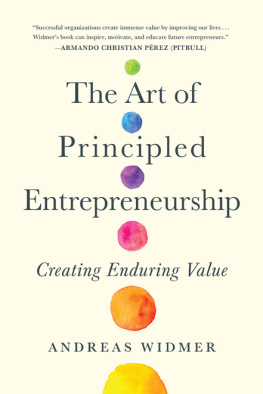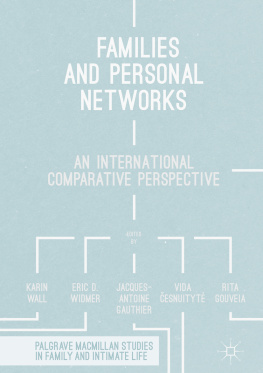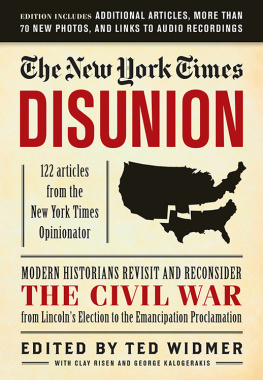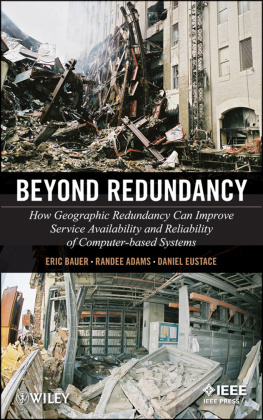First published 2010 by Ashgate Publishing
Published 2016 by Routledge
2 Park Square, Milton Park, Abingdon, Oxon OX14 4RN
711 Third Avenue, New York, NY 10017, USA
Routledge is an imprint of the Taylor & Francis Group, an informa business
Copyright 2010 Eric D. Widmer
All rights reserved. No part of this book may be reprinted or reproduced or utilised in any form or by any electronic, mechanical, or other means, now known or hereafter invented, including photocopying and recording, or in any information storage or retrieval system, without permission in writing from the publishers.
Eric D. Widmer has asserted his right under the Copyright, Designs and Patents Act, 1988, to be identified as the author of this work.
Notice:
Product or corporate names may be trademarks or registered trademarks, and are used only for identification and explanation without intent to infringe.
British Library Cataloguing in Publication Data
Widmer, Eric
Family configurations : a structural approach to family
diversity.
1. Families.
I. Title
306.85-dc22
Library of Congress Cataloging-in-Publication Data
Widmer, Eric
Family configurations : a structural approach to family diversity / by Eric Widmer.
p. cm.
Includes index.
ISBN 978-0-7546-7679-9 (hbk) -- ISBN 978-0-7546-9350-5 (ebook) 1. Families. 2. Interpersonal relations. I. Title.
HQ519.W54 2010
306.87--dc22
2010014457
ISBN 978 07546 7679 9 (hbk)
ISBN 978 13155 8190 3 (ebk)
Introduction
From the Family Institution to Family
Configurations
In the 1920s, Ernest Watson Burgess, a leading representative of the Chicago School and one early family sociologist, characterized the great changes that families experienced during his life time by a new relational model (Burgess, 1926; Burgess, Locke and Thomes, 1960). Rather than building a moralistic discourse regarding the decline of the Family, as so many scholars of his time did, Burgess earnestly tried, by the use of empirical research, to understand the patterns that made the new kind of family experiences that he discovered so different from those of the close past. Ultimately, his research stressed the emergence of the Companionship Family, which replaced the Family Institution: love against parental supervision of mate selection, privatization of family life against community interference, equality between husband and wife against patriarchy. In his view, the Companionship model, based on a long-term commitment of spouses linked by democratic arrangements and a functional specialization within the nuclear family, was about to fully erase from Western societies the last remnants of rural forms of family life, doomed by modernity. The Family was constituted by a small and lasting group of interacting personalities linked by meaningful social roles, a feeling of shared belonging and a legitimate although unequal division of labour. In Burgesss view, actual interactions rather than legal contracts defined families (Burgess, 1926). Based on the empirical investigation of such interactions, he stressed the reorganization of modern families along new structural principles, rather than interpreting the already increasing divorce rates as evidence for the disorganization of the Family.
Towards the end of the 1980s, after divorce, non-marital cohabitation and changing gender roles made it clear that things had changed once again in the family realm, some prominent scholars cast doubt on the survival of a functional stable model of family. The diversity of families had become so great, they said, that any attempt to find general principles underlying their organization was doomed. Indeed, childless families, dual-earner families, living-apart couples, single-parent families, step-families, same-sex partnerships, families constituted by friends and adopting families are various alternatives that currently compete with the model of the nuclear family, constituted by the main earner male, his wife and their co-resident Each of these families can be further decomposed in subtypes with their own structures and roles. Step-families, for instance, cover a variety of situations: couples with resident step-children from the female partner, couples with resident step-children from the male partner; couples with resident step-children on both sides; couples with a mix of shared and non-shared children; couples with resident step-children and non-resident step-children, etc. The number of possible family structures following divorce and remarriage is so important that one may wonder if the step-family as an homogeneous concept is truly valid.
In relation to this diversity of family structures, there is an ongoing debate among sociologists, especially in North America, regarding the use of the plural or the singular concerning the family realm. Should we talk about the Family or about families? The majority of family researchers have opted for the second solution by arguing that the diversity of family structures and experiences has become so great that referring to the Family is at best confusing, at worst a gross scientific misconception, laden by normative biases stemming from a nostalgia for the nuclear family. Frightened by the perspective of imposing a single model of family life as a norm or an ideal to which all family structures should be referred, some scholars have celebrated the diversity and fluidity of family experiences (Stacey, 1990, 1993).
Others, destabilized by the diversity of families, have developed a pessimistic perspective on their future. As a matter of fact, sociology since its origin has often developed negative views regarding family change. The lack of a normative model of family commitment, stemming from individualization trends, will supposedly make the Family collapse. The books of David Popenoe in the United States are often given as particularly eloquent examples of that perspective (Bengston, 2001): the decreasing number of children in families, the increasing divorce rates and economic independence of women are indicators in this perspective of the declining role of families in modernity (Popenoe, 1993, 2005). In Europe, Ulrich Beck and colleagues took over the same line of thought by emphasizing the deleterious influences of individualization forces on the Family. A mass society of eremites unable to maintain any long commitment is about to come (Beck, 1986; Beck and Beck-Gernsheim, 2002b). Family is a zombie category shredded apart by the strong cultural and economic enforcement on individuals to live a life of their own, which has left little in terms of private commitments and family care. In a more positive light, Anthony Giddens emphasized the self-referencing internal process of intimate partnership formation and development. His perspective, although less pessimistic, reduced the significance of the social embeddedness of dyadic processes and hence made it difficult to understand for whom and how family relationships still continue to matter. Giddens concept of pure relationship, which is an archetype of late modernity according to him, focuses on self-exploration, negotiation and symmetry in power relations, and decidedly weaker external constraints on intimate relationships (Giddens, 1991, 1995). In all cases, the possibility for scholars to find models of long-term commitments in such individualized families has been considered highly improbable.








